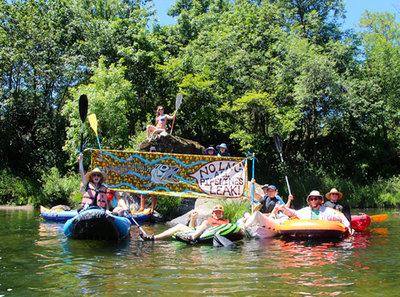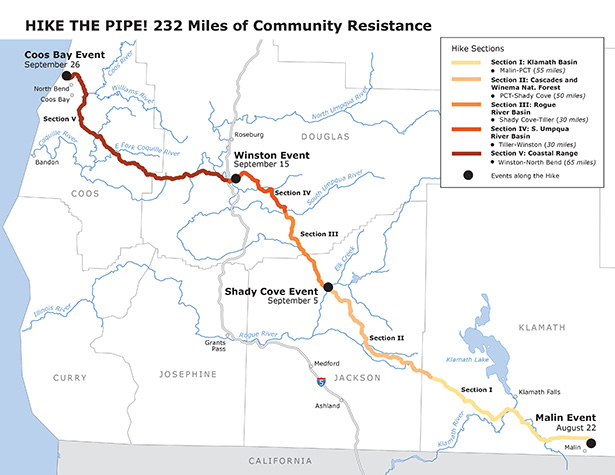
The proposed Jordan Cove liquefied natural gas (LNG) terminal in Coos Bay would produce 2.1 million metric tons of CO2 a year, according to its federal environmental analysis. And the project isn’t just an LNG terminal. It’s a gas liquefaction, storage and shipping facility with a 400-megawatt natural-gas-fired plant powering four super chillers. It will all be fed by a 36-inch-wide 232-mile natural gas pipeline extending halfway across Oregon.
The project could export up to 6 million metric tons of LNG per year, according to the Department of State Lands (DSL).
Hike the Pipe is a trek from the pipeline’s start in Malin, near the California border, all the way to Coos Bay. The hikers seek to call attention not only to the climate-changing impacts of the greenhouse-gas emitting LNG plant, but also the impacts the pipeline project will have on forests, homes and waterways.
The pipeline will have the capacity of up to one billion cubic feet of natural gas per day, DSL says.
Grace Warner of Hike the Pipe says hikers will trek the entire pipeline over several weeks at a rate of about 7 miles a day. Other hikers, including Warner, will join the core group for portions of the hike, and the public is invited to hike or come to one of four community events along the way.
Warner says the hike will “document the direct impacts of the pipeline and interact with the communities who live along the course of the Pacific Connector Pipeline.”
It’s a climate justice issue, Warner says, of the impacts of the project.
At one point, the pipeline route crosses the Pacific Crest Trail, Warner tells EW, and the almost 100-foot clearcut that will be made to install the pipeline and the smaller 50-foot permanent easement for the pipe will mean the loss of old-growth trees and endangered species habitat in parts of the Winema National Forest.
The pipe will also cross 400 waterways, including the Rogue and Klamath rivers, as well as traversing private property. Some of that private property will be taken as a pipeline right-of-way through eminent domain.
Jordan Cove is owned by Calgary Veresen Inc. out of Canada, and Williams Co. out of California co-owns the pipeline with Veresen.
The hike will follow the route of the pipeline, Warner says, but on areas of private land hikers will stick to nearby public roadways. She says there will be events in Malin, Shady Cove, Winston and North Bend that will give community members opportunities to meet the hikers and get involved with the issue.
The Federal Energy Regulatory Commission (FERC) has said it will put out its final environmental impact statement on the project at the end of September and then, after public comments and revisions, deliver final authorization by the end of December.
Warner says Hike the Pipe hopes Gov. Kate Brown will file a petition for rehearing if the FERC decision goes through. Several environmental groups, including Coos Waterkeeper and Greenpeace, are awaiting a decision on a petition for judicial review from the Oregon Court of Appeals in regard to a DSL permit for part of the project.
The hike begins Aug. 22 in Malin. For more information or to participate, go to hikethepipe@gmail.com or Facebook.com/hikethepipe.
